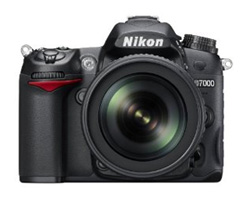The Best Nikon Digital SLR Camera
When I think of the "best" digital SLR Nikon has to offer, I'm considering two things:
- What feature set are you getting?
- How much do you have to pay?
For example, Nikon makes a variety of cameras specifically designed for professional working photographers. Compared to other Nikon cameras, these could be considered the best.
However, the price tags for the camera body alone without lenses typically exceed $3,000 USD.
Since this amount of money and level of performance is beyond the needs of the typical family photographer I don't include these cameras in my analysis.
Having said this, I believe that the best Nikon digital SLR is the Nikon D7000 (Release Date: October 2010).
Snappy Performance
If you want to take pictures of fast-moving subjects, then the Nikon D7000 is the camera for you.
It can capture consecutive images at a rate of 6 per second, and the 39-point autofocus system can lock and track subjects as they move across the frame.
A maximum shutter speed of 1/8000th of a second provides you with the ability to freeze any type of motion — even if all you see with your eyes is a blur.
Finally, a maximum ISO setting of 25600 provides you with the ability to achieve fast shutter speeds even in moderate to dim available light.
Advanced Video
The predecessor of the D7000 - the Nikon D90 - was the first digital SLR to include a video capture mode.
The video mode on the D90 suffered from some limitations: autofocus didn't work and the quality of the video was limited to High Definition 720p.
The D7000 overcomes these limitations with Full HD 1080p quality and the ability to autofocus when making movies.
When you leverage Nikon's extensive line of lenses, you can create some truly unique points of view for your videos.
Lens Compatibility
While the Nikon D7000 is not the most advanced camera Nikon makes (those are the ones reserved for pro photographers) is is more feature-rich than the Nikon D5100 or the Nikon D3100.
The most substantial difference between the D7000 and its less expensive cousins is that the D7000 is 100% compatible with a huge number of Nikon lenses (old and new) and third party lenses.
The D7000 has a built-in autofocus motor so the lenses you use with it don't have to have motors of their own.
By contrast, both the D51000 and D3100 lack autofocus motors: this means that if the lens doesn't have a focus motor, autofocus won't work.
Being able to choose between hundreds of lenses is probably not a priority for beginning photographers. For people with some experience using DSLRs or those who want to use specialty lenses, being able to choose ANY lens is a big advantage.
Build Quality
Many less expensive digital SLR cameras are built from a frame made of plastic.
The frame of the Nikon D7000 is magnesium alloy — this metal frame is heavier than plastic and gives the camera a more "solid" feel in your hand.
Built quality is subjective: while some people won't be happy with the extra weight, others will appreciate the heft and balance.
If you take lots of hand-held pictures at slower shutter speeds, having the extra weight helps to keep the camera stable.
Dual Cards
The Nikon D7000 has dual SD memory card slots.
This provides you with a variety of options about how you save your digital images and video on the cards.
First, they can be used in "overflow" mode — as soon as one card fills up, the camera automatically starts using the second card.
If you take RAW and JPG pictures at the same time, you can set it up so that all the RAW images are on one card and the JPGs are on the other.
Finally, if you alternate between pictures and video, you can dedicate one card for photos and the other for movies.
Related Links

|




